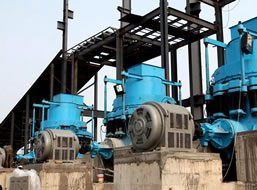Aluminum smelting is primarily achieved through the Hall-Héroult process, an electrolytic method that extracts aluminum from its oxide (alumina, Al₂O₃). Here’s a detailed breakdown:
1. Key Steps in Aluminum Production
– Bauxite Mining: Aluminum is extracted from bauxite ore, which contains 30-60% alumina (Al₂O₃).
– Bayer Process: Bauxite is refined into pure alumina via digestion in NaOH, precipitation, and calcination.
– Hall-Héroult Process: Alumina is dissolved in molten cryolite (Na₃AlF₆) and electrolyzed to produce aluminum metal.
.jpg) 2. Electrolysis in the Hall-Héroult Process
2. Electrolysis in the Hall-Héroult Process
– Cell Setup:
– Anode (Carbon): Oxidized to CO₂ (consumable).
– Cathode (Carbon-lined steel): Reduces Al³⁺ to molten aluminum.
– Electrolyte: Molten cryolite (Na₃AlF₆) at ~950°C (lowers alumina’s melting point from 2072°C to ~900°C).
– Reactions:
– At the cathode:
\[
\text{Al}^{3+} + 3e^- \rightarrow \text{Al(l)}
\]
– At the anode:
\[
2\text{O}^{2-} + \text{C} \rightarrow \text{CO}_2 + 4e^-
\]
– Energy Intensive: Requires ~12–15 kWh per kg of Al due to high temperatures and electrical demands (~4–5 V per cell).
3. Challenges & Innovations
– Carbon Footprint: CO₂ emissions from anode consumption (~1.5 kg CO₂ per kg Al). Solutions include inert anodes (e.g., Ni-Fe alloys) and renewable energy.
– Cryolite Alternatives: Researchers explore low-temperature electrolytes to reduce energy use.
4. Secondary Aluminum Production
Recycling scrap aluminum uses only ~5% of t energy required for primary production, making it highly sustainable.
energy required for primary production, making it highly sustainable.
Key Takeaways
– Aluminum smelting relies on electrolysis of alumina dissolved in cryolite.
– The process is energy-intensive but critical for lightweight metal production.
– Future advancements focus





Leave a Reply